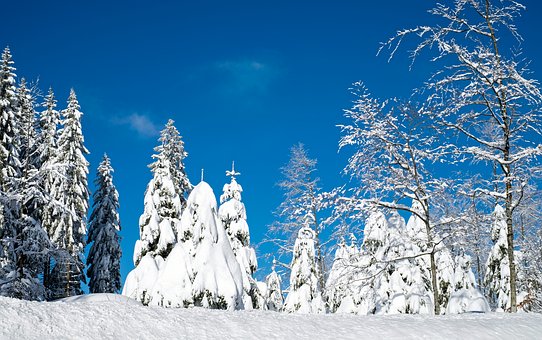How to Care for Your Trees in Winter

As summer ends and fall comes, days get shorter and shorter. This signals trees to begin getting ready for winter. They shut down their “food-making factories” (leaves), a membrane (abscission layer) forms between the leaves and twigs, leaves stop photosynthesizing and the chlorophyll fades, leaves fall off and the living tissues in the trunk and branches go through hardening. After the trees have gone through the hardening process, they are now ready for winter.
Even though trees have a strong natural defense mechanism against extreme weather, there is a lot you can do to help them prepare, as well. Below are ways you can help your trees prepare for winter.
Plan to Prune
Anyone with trees on their property, particularly deciduous trees, knows how vulnerable the branches are to breakage during winter. This is because the stems harden and become more brittle and susceptible to wind damage. The key to reducing branch breakage lies in proactively pruning your trees during the dormancy phase.
Pruning weak and vulnerable branches can help make the whole tree less susceptible to breakage. This maintenance practice allows air and sunlight into the center of the tree, enough to promote healthy growth during winter. Additionally, pruning during the dormancy period prevents the spread of diseases since disease-causing organisms are also dormant during this time.
Fertilizing
Extreme temperatures (heat wave, cold wave) can have a detrimental effect on tree roots. They cause leaching of essential plant nutrients in the soil. Before the first freeze, fertilize your trees to replenish the nutrients that were lost during the hot, dry summer months. Use a slow-release fertilizer since it will continue to supply nutrients to the tree during extreme weather.
Watering
Right up until the point the ground freezes, it’s important to water your tree sufficiently so it will have sufficient reserves to survive the winter season. Newly planted trees or young trees need more frequent watering compared to trees that are well established. Evergreen trees will also need ample water since they retain their leaves and never go completely dormant.
Mulch
Low winter temperatures can make it hard for trees to get enough water since the water around the roots may be frozen. Your trees could, therefore, have a tough time absorbing water during winter. To avoid this, place a layer of organic mulch around the base of the trees. The mulch may consist of grass clippings, wood chips, and leaves among other items.
Mulching your trees will help retain soil moisture as well as increase winter soil temperature. This way the soil will retain enough water making it available to your trees when needed.
Keep Critters Away
Rabbits, mice, squirrels and other animals like deer can cause problems to your trees during winter. Since they won’t have a lot of options regarding sources of food, rodents may be forced to resort to your trees for sustenance. The problem can get worse if you place a layer of mulch beneath the drip line of the tree.
You may want to leave some room between the mulch and the trunk of the tree. You can also look for traps or bait to keep the rodents from climbing up the tree and causing damage. Another option is to place a chicken wire or wire mesh around the base of the tree to prevent rodents from eating the bark of the tree.
Losing a considerable amount of bark to hungry rodents can damage the tree in the long run, so this is a problem you shouldn’t take lightly.
Clear the Snow
Heavy and wet snow can cause substantial damage to your trees. Its weight can break or split branches and can even cause trees such as arborvitaes to be uprooted or fall over. Use a soft broom to remove any snow that may have accumulated on the leaves and branches, a heavy tool like a broom handle or a shovel can damage the bark of your tree.
If there are branches that are susceptible to snow load, install bracing during winter to help support them when snow falls. For huge snowstorms, remove heavy snow from weak trees while it is still falling instead of waiting until the snow freezes.
Trees add much-needed shade, color, privacy, and value to your backyard. Therefore, they should be nurtured and protected year-round to make sure that they stay healthy.

















